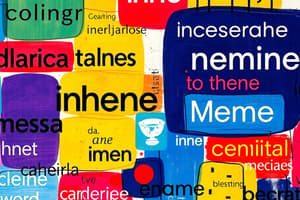Podcast
Questions and Answers
What is the primary function of media that serves as a source of information about the world?
What is the primary function of media that serves as a source of information about the world?
- Correlation
- Sensationalization
- Transmission
- Surveillance (correct)
How does the media typically present facts according to the concept of Correlation?
How does the media typically present facts according to the concept of Correlation?
- Without bias and independently
- In a sensational manner
- With a subjective perspective (correct)
- Through objective reporting
Which media function emphasizes the idea of 'if it bleeds, it leads'?
Which media function emphasizes the idea of 'if it bleeds, it leads'?
- Entertainment
- Sensationalization (correct)
- Surveillance
- Transmission
In what way does mass media contribute to cultural socialization?
In what way does mass media contribute to cultural socialization?
Which of the following best describes the entertainment function of media?
Which of the following best describes the entertainment function of media?
Which of the following statements reflects a common misconception about information presented in mass media?
Which of the following statements reflects a common misconception about information presented in mass media?
What role does mass media play in the context of personal decision-making?
What role does mass media play in the context of personal decision-making?
What is often a consequence of sensationalization in media?
What is often a consequence of sensationalization in media?
What is a key objective of Module 1?
What is a key objective of Module 1?
Which of the following is NOT a topic discussed in Module 1?
Which of the following is NOT a topic discussed in Module 1?
What is meant by 'intersemiotic relations' as mentioned in the lessons?
What is meant by 'intersemiotic relations' as mentioned in the lessons?
How is language described in the context of Module 1?
How is language described in the context of Module 1?
The module encourages the exploration of which of the following?
The module encourages the exploration of which of the following?
In the context of media usage today, what is an important aspect to discuss?
In the context of media usage today, what is an important aspect to discuss?
Which of the following best describes 'mediated discourse'?
Which of the following best describes 'mediated discourse'?
What challenge does Module 1 address regarding preconceived notions?
What challenge does Module 1 address regarding preconceived notions?
What does semiotics primarily study?
What does semiotics primarily study?
Which of the following best describes semiotic modes?
Which of the following best describes semiotic modes?
How does the materiality of media influence communication?
How does the materiality of media influence communication?
What kind of social interaction does using the Instagram app encourage compared to a physical photo album?
What kind of social interaction does using the Instagram app encourage compared to a physical photo album?
Which sensory mode is NOT mentioned as a semiotic mode?
Which sensory mode is NOT mentioned as a semiotic mode?
Which publication focuses specifically on the relationship between language, media, and culture?
Which publication focuses specifically on the relationship between language, media, and culture?
Which interaction type is affected by media materiality?
Which interaction type is affected by media materiality?
What is a key difference between social interactions on Instagram compared to a traditional media format?
What is a key difference between social interactions on Instagram compared to a traditional media format?
What is the focus of the Routledge Handbook of Remix Studies and Digital Humanities?
What is the focus of the Routledge Handbook of Remix Studies and Digital Humanities?
Which authors contributed to the book discussing language and media education resources for students?
Which authors contributed to the book discussing language and media education resources for students?
What defines the range of messages conveyed through a medium?
What defines the range of messages conveyed through a medium?
What is one of the main themes explored by Dovchin in her work?
What is one of the main themes explored by Dovchin in her work?
Which publication examines media literacy's potential and challenges?
Which publication examines media literacy's potential and challenges?
What is meant by decontextualization in the context of global visual language?
What is meant by decontextualization in the context of global visual language?
Which characteristic of global visual language allows for a wide range of settings to be signified by an image?
Which characteristic of global visual language allows for a wide range of settings to be signified by an image?
How does timelessness contribute to global visual language?
How does timelessness contribute to global visual language?
What is haptic communication primarily related to?
What is haptic communication primarily related to?
Which of the following best describes the relevance of olfaction in recent years?
Which of the following best describes the relevance of olfaction in recent years?
What does the term 'meaning potential' refer to in global visual language?
What does the term 'meaning potential' refer to in global visual language?
Which of the following manipulations in touchscreen interactions is considered part of haptic communication?
Which of the following manipulations in touchscreen interactions is considered part of haptic communication?
In what way has social media, like Instagram, influenced self-image among young audiences?
In what way has social media, like Instagram, influenced self-image among young audiences?
Flashcards are hidden until you start studying
Study Notes
Introduction to Language and Media
- Focuses on the intersection of language and media, covering basic concepts and their interrelation.
- Explores forms of communication associated with media, including newspapers, films, and social media.
- Challenges preconceived notions of language and media by analyzing interactions between messages and societal expectations.
- Understanding requires combining knowledge of existing frameworks with contemporary societal ideas.
Module Objectives
- Grasp the relationship between language and media and their mutual influences.
- Familiarize with key concepts relevant to language and media.
- Explain contemporary uses and misuses of language and media.
- Discuss current issues surrounding language and media.
Lesson 1: Language and Mediation
- Language is a communal phenomenon that shapes and is shaped by media interactions.
- Examples include reliance on podcasts for decision-making, indicating personal engagement with media content.
Lesson 2: Media Uses and Users
- Functions of Media:
- Surveillance: Acts as the primary source of information through various channels (TV, internet, newspapers).
- Correlation: Media presents information that influences perceptions and understanding - often biased.
- Sensationalization: Media prioritizes engaging content, exemplified by the adage "if it bleeds, it leads."
- Entertainment: Media serves dual purposes of informing and entertaining, catering to public leisure time.
- Transmission: Transmits cultural norms and values, playing a critical role in socialization and behavior modeling.
Intersemiotic Relations
- Semiotics: Study of meaning generation through signs, including language, images, and objects.
- Semiotic Modes and Relations:
- Multimodal texts combine various semiotic modes like language, visuals, and sounds to convey messages effectively.
- Semiotic modes are characterized by different perceptual experiences that shape how we interpret messages.
Media Materialities
- The physical characteristics of media impact social interactions surrounding communication.
- Example: Comparing shared family photo albums with the solitary experience of browsing social media platforms like Instagram.
- Impact of Materiality:
- Determines usage context, communication participants, and message formats.
Lesson 4: Global Modes and Future Modes
-
Characteristics of Global Visual Language:
- Decontextualization: Representations become generalized, losing specific cultural ties.
- Attributes: Images can signify multiple settings, promoting versatility in usage.
- Timelessness: Visual language maintains a stable global vocabulary.
- Meaning Potential: The contextuality of meaning varies based on the audience and setting.
-
Characteristics of Future Modes:
- Tactile Sensation: Haptic communication becoming prevalent through touch-screen devices, influencing user interaction.
- Olfaction: Increased attention to the sense of smell in media, expanding sensory engagement.
These study notes provide a structured overview, capturing the essence and critical elements within the Language and Media module while highlighting the interconnectedness between language, media, and societal dynamics.
Studying That Suits You
Use AI to generate personalized quizzes and flashcards to suit your learning preferences.




